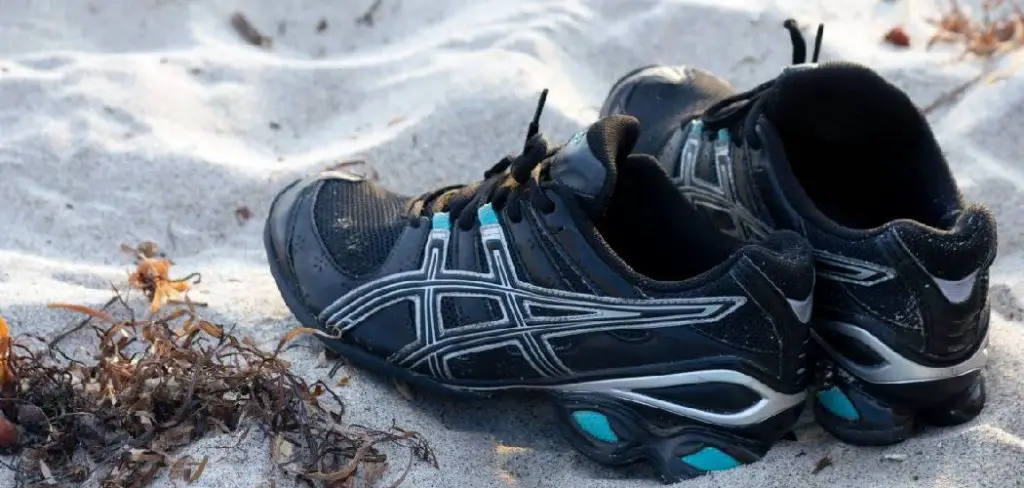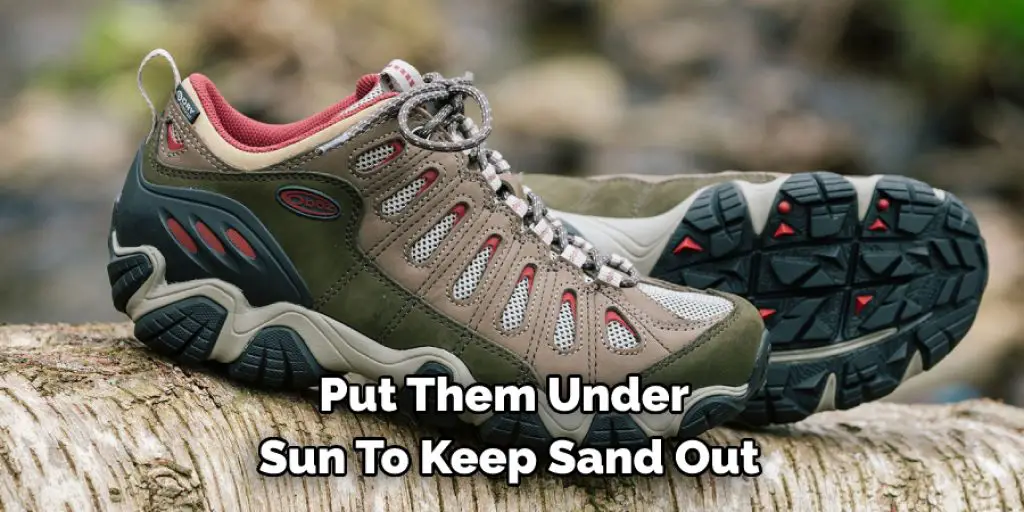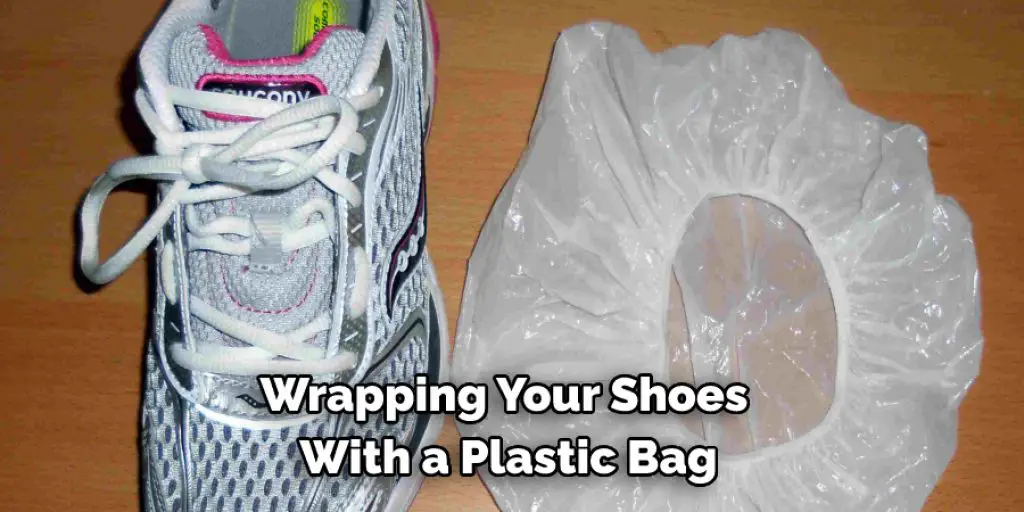No one likes getting sand in their shoes, especially when running. It’s annoying, and it can be a real pain. This article will discuss how to keep sand out of running shoes. Hopefully, these will help you avoid the nuisance altogether!

Running shoes are great for fitness and great for covering distance. The only downside is that they can be challenging to clean, and if you go running on the beach, it’s almost impossible. Now, we all know what sand looks like, so there’s no point in describing it – we need to figure out how to avoid it getting into our shoes!
Summary: Sand is a common issue while running, especially if you do it on a beach or any sandy area. To keep sand out of running shoes, there are a few tips to follow. Firstly, it is best to wear shoes made from breathable and lightweight materials that have mesh layers to prevent sand from entering the inside of your shoes. Additionally, using gaiters or wearing socks that cover your ankles can also help to keep sand from entering your shoes.
A Step by Step Guide on How to Keep Sand Out of Running Shoes
Step 1: Remove Insole of your Shoe
The first step is to take out your shoe’s insole. This will allow you to shake the sand out more efficiently, and it also makes it more convenient so that you can focus on applying the tape straight to your shoes without worrying about removing it afterward. Next, you’ll need a flat head screwdriver or something similar; check if your shoe has any removable parts when you buy them (it may be tucked away under the tongue).
Step 2: Shake Your Shoe
The best way to shake the sand out of your shoe is with your foot in it. As you rock your shoe back and forth, pay attention to the toe area where the most sand will be. You can also use a vacuum cleaner or even a small handheld one if you have something that has suction power.
Step 3: Beat Shoes Against Wall
If you’re still unable to get rid of the sand entirely, you can beat your shoes against the wall. Be careful doing this without shoes on since it’ll cause some impact to your feet. If you have something like an old t-shirt or rag, wrap them around your shoe first before hitting it against the wall; otherwise, the sand will fly everywhere and probably blow right back into your other shoe (been there, done that).
Step 4: Use High-Pressure Hose
A hose is an excellent tool for this since it can accurately point at your shoes and blow out all the sand. However, if you prefer more control and precision, you can use a handheld vacuum cleaner or even a handheld high-pressure cleaner like those used in car washes.

Step 5: Place Sand Removal Paper inside Shoe
This is an extra step that some people like to take. Use lightweight paper (newspaper, printer paper) and place it at the bottom of your shoe; this will ensure that any loose grains of sand don’t get stuck later on or even cause damage to other parts of your shoe by scratching over them as you walk around.
Step 6: Stick the Tape onto Your Shoe
After you’ve shaken all of the sand out, it’s time to ensure that there aren’t any leftovers. Put tape over your shoes (make sure it’s sticky side up) and move it around with your hands to ensure that every nook and cranny is covered. You can use duct tape or even clear packing tape; try both to see which one works best for you.
To take it off, grab a corner of the tape and pull it back on itself. Try this a few times to make sure that your shoe isn’t going to be sticky later. If you do end up with residual stickiness, you can also apply talcum powder or even baby powder afterward to remove it. This is especially important if you’re wearing the shoes in an environment that could get dirty again quickly (beach, pool).
Step 8: Vacuum
After the tape has dried for a minute or two, it’s time to make sure that all of the sand is stuck. This part can get pretty annoying depending on how much remaining sand there is, but don’t worry because you’ll only have to do this step once if you’ve done everything correctly. If necessary, you can use a high-pressure hose again, your handheld vacuum cleaner, or even a more giant vacuum cleaner.
Step 9: Wash Your Shoe
After taking off the tape, it’s time to wash your shoe. How frequently you do this is up to you; some people only have to do it once every few months, while others find that they need to clean them as soon as they get home from a run or workout. If there was a lot of sand on the ground during your activity, it might be easier for particles to stick onto your shoes and cause damage.
Running shoes are meant to repel water and mud so that we can prevent injuries and accidents when exercising in different types of terrain.
Step 10: Put them under Sun.
Lastly, make sure that you let your shoes dry completely before putting them back on. If it’s summer and your boots are still wet, then put them in the shade; direct sunlight can cause premature wear and tear at this stage (it might be a good idea to avoid wearing shoes that aren’t dried out or do activities like gardening or playing with children). These steps will help in how to keep sand out of running shoes.

You Can Check It Out to Is It Ok to Wear Running Shoes for Walking?
Tips and Warnings
Tips:
- Wear shoes with mesh uppers to help reduce the amount of sand inside your shoes.
- Keep running shoes in the shade so they don’t absorb as much heat and melt more sand.
- If you are looking to buy new running shoes, but ones that come with mesh uppers or pick up some shoe goo to help reduce the amount of sand that gets into your shoes.
Warnings:
- Some people find it helpful to apply sunscreen or insect repellent to their feet before running in the sand. However, make sure none of these chemicals are transferred onto your shoes when you put them on.
- This is not a long-term solution. Even if you cannot see the sand, it is still inside your shoes and can eventually get to your feet.
- This method does nothing to protect against hot coals, glass shards, or other sharp objects on the ground. Use caution when running in the sand.
You Can Check It Out to Can You Waterproof Mesh Running Shoes
Prevent Beach/sand From Getting Into My Running Shoes
Running along the beach, ocean, or even a city street during the summer can be lovely. Unfortunately, these surfaces are often covered in sand, which can find their way into your running shoes. Fortunately, there are several things you can do to prevent this from happening.
1) Plan Your Run When You Know The Area Will Be Free of Debris
If possible, try to make sure you are not running where it looks like there will be lots of debris on the ground. For example, if you know that people will be at the beach celebrating at lunchtime, then maybe try for an early morning run instead.
2) Cover Your Shoes With A Plastic Bag If You Can’t Avoid Running Where There Is Sand/debris On The Ground

If you know that there will still be sand and debris on the ground when you run, then wrapping your shoes with a plastic bag will protect them. It may look kind of funny, but it works!
3) Wash Your Shoes With Water And Dish Soap When You Get Home
When washing your running clothes after a workout, always remembers to add in some dish soap to help get rid of all the sand particles that have been collected from your run.
You Can Check it Out to Do Snow Pants Go Over Boots
Frequently Asked Questions
Is It Better to Run With Shoes on in Sand?
It depends on a variety of factors, including the type of sand you’re running in and your personal comfort level. Some people prefer to run in shoes because they think it gives them more stability and prevents them from slipping. Others feel that running barefoot in sand is more natural and allows them to feel the terrain better. Ultimately, it’s up to you – just make sure you’re comfortable and safe while you’re out running!
Which Shoes Are Best for Running in Sand?
The best shoes for running in sand may vary depending on your individual foot type and conditioning. However, some of the most popular shoes that are effective for running in sand include the Nike Free Run+ 2.0, Brooks Adrenaline GTS 17 Running Shoes (Women’s), Saucony Mirage 6 Women’s Running Shoe, New Balance CT2W “Motion Control” walking/running shoe. Each of these footwear options features a lightweight design that gives you excellent flexibility and stability while running in soft or hard surfaces like sand.
Are Trail Running Shoes Good for Sand?
Some runners find that sand does not migrate through the rubber and mesh material on their shoes like it does with other surfaces, others have reported problems with blisters and other skin irritations. In general, you should always test a small area of your shoe before actually wearing them in potentially sandy conditions.
If you do experience any issues, be sure to clean both the shoe and the foot thoroughly with soap and water after every run.
Why is Running on Sand Difficult?
Running on sand is difficult because it absorbs energy and creates traction that can pull you in multiple directions. When running, your foot must take the majority of the impact while your body pushes forward to propel you forward. However, when running on sand, each step sends shockwaves through the particles which creates an opposing force that pulls you backwards.
Additionally, if stepping in deep water or mud (which are also related to poor footing), these foreign objects will cause a V-shaped ditch leading away from them into which your legs may be pulled under by gravity or other muscles working against you. This phenomenon is known as “the tuck.”
So what’s a runner to do? If possible try switching terrain altogether – mixing things up by trying grasses or dirt roads for example – but if none of those work consider wearing shoes with spikes so that even small amounts of extra grip can help make sure footing stays stable.
Conclusion
If you take the necessary precautions, your running shoes will last much longer, and you’ll be able to avoid getting sand in them. By following these tips on how to keep sand out of running shoes, you can keep your sneakers clean and free of debris so that your runs are more comfortable and enjoyable.

